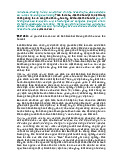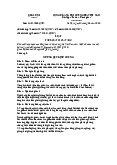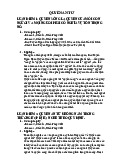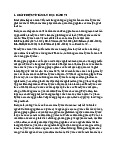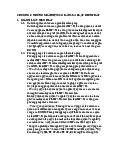


Preview text:
Listening 1. Tort Law: Three Types of Torts
Torts are (1) ____________________ that are done by one party against another. As a result of the
wrongdoing, the injured person may take civil action against the other party. To simplify this, let's say while
walking down the aisle of a grocery store, you slip on a banana that had fallen from a shelf. You become
the plaintiff, or injured party, and the grocery store is considered the tortfeasor or defendant, the negligent party.
Simply said, you would probably take (2) ____________________ action against the grocery store to
recoup compensation for pain, suffering, medical bills and expenses incurred as a result of the fall.
Negligence is just one tort category. There are three general categories of torts. Regardless of the tort action,
three elements must be present: • Tortfeasor defendant , or
, had a duty to act or behave in a certain way. •
Plaintiff must prove that the behavior demonstrated by the tortfeasor did not conform to the duty owed to the plaintiff. •
The plaintiff suffered an injury or loss as a result.
Because torts are a civil action involving (3) ____________________ parties, punishment does not include
a fine or incarceration. The punishment for tortious acts usually involves restoring the injured party
monetarily. Sometimes a court order may force the tortfeasor to either do or not do something. Think
trespassing, defamation or slander. Let's explore the three types of torts: • Intentional torts • Negligence torts • Strict liability torts Intentional Torts
An intentional tort is an act that is intentionally committed against another person with the aim of causing
harm. There are several intentional torts that fall into this category, like assault, battery, conversion, fraud,
false imprisonment trespassing ,
and invasion of privacy. Not every injury-producing action is cause for
an intentional tort lawsuit. The court will look at the conduct of the defendant to determine whether the
actions were, in fact, intentional or just mere willful and wanton behavior not specifically meant to cause
fear or injury, but is considered (4) ____________________.
Betty Geeslin, a personal representative of Bill Geeslin in Bill Geeslin v. Kobe Bryant, is one of those cases. Back in November of
2005, Geeslin and a friend attended a Lakers/Grizzlies game. The fans held courtside seats for the event. At some point during the
game, famous basketball player Bryant ran to retrieve an out-of-bounds ball. As he reached for the ball, he lost his footing and fell
atop Geeslin, leaving him with injury to his chest and lungs. After several days, Geeslin, now home, began experiencing
uncomfortable pain in his chest severe enough to visit an emergency room. Once examined, it was diagnosed that he suffered a
bruising and a crushed lung. He was prescribed several pain medications and a breathing machine and sent home.
After a few weeks of home treatment, Geeslin decided to sue Bryant for assault, battery and infliction of emotional distress.
Geeslin claimed that when Kobe attempted to remove himself from Geeslin's chest, he used extreme force to push away, causing 1
injury. Geeslin also claimed that he could no longer sleep at night, suffered anxiety and felt embarrassed by the incident in general.
When the court analyzed the case, it felt that the elements for tortious behavior were not present. Specifically, Geeslin assumed
the risk of injury by choosing courtside seats. Bryant in no way intended to cause injury to Geeslin at the time of the initial fall or
as he attempted to return to the court, and a reasonable person would not conclude that the incident was so seriously traumatic that
Geeslin suffered emotional distress to the degree he claimed. In a motion for defendant's summary judgment, the court ruled in favor of Bryant.
On a side note, Geeslin died prior to final judgment and a personal representative maintained the claim against Bryant until time
of final judgment. However, Bryant settled with the estate out of court for the sum of $75,000 to put a rest to any further appeals
or complaints against him. Our next torts deal with actions that cause injury that do not have intentional characteristics. Negligence Torts
Negligence occurs when a party fails to demonstrate the kind of care a prudent person would take in the
same situation and an injury results from the action or inaction. There are five elements necessary to prove a negligence case : •
Defendant owed a duty of reasonable care. •
Defendant did not behave in a reasonable manner to demonstrate care. •
Plaintiff suffered an injury as a result of the defendant's actions or inactions. •
The injury caused actual damages. •
Proximate cause: defendant's actions or inactions were the cause of injury.
While these elements seem (5) ___________________, they are necessary for a negligence case. Let's see
what happens in a comical case involving negligence. In Byrne v. Boadl
e (1863), Byrne was walking down the street when a barrel full of flour fell out of a window and landed upon
him, causing the plaintiff injury. In this case, the flour shop owed anyone walking on the sidewalk below the window a duty of
care. In other words, a flour barrel should not be in a window where it could fall. The defendant should have used reasonable care
that the flour barrels are stored in an area of the shop where injury to a passe -
r by could not possibly happen. Byrne was injured
because of the flour shop's negligence in storing flour barrels appropriately, leaving the flour shop solely responsible for this
injury. Needless to say, this was a prima facie cas
e because the evidence was strong enough on face value to convince a court to
rule in favor of the plaintiff. Strict Liability Torts
Cases involving strict liability are similar to negligence. In these instances, the defendant may be
responsible for (6) ___________________ even if the defendant was not negligent. This may seem counter-
intuitive, but it makes sense. Let's take the dog bite law as an example.
In many states, a dog owner is responsible for any injury resulting from the dog biting another person. If the defendant's dog has a
predisposition to snap or act aggressively toward people, or has been known to attack without provocation and bites a person, the
owner can be strictly liable for the actions of the dog. Strict liability applies whether the owner took all precautions, like a leash or
a fenced-in pen, or not. By simply owning the dog, the owner takes responsibility for its behavior.
There are a few conditions that the owner may not assume the responsibility. If a trespasser enters the home, a dog may bite the
person. A dog may even nip his veterinarian without owner liability. If a person provokes the dog to the point of angering the
pooch, the owner may not be liable. Finally, there is no liability if the dog is aiding a police or military officer during official duty.
Of course, there is no federal law governing strict liability and dog bites. It is always best to check with your state for further information. 2 3
